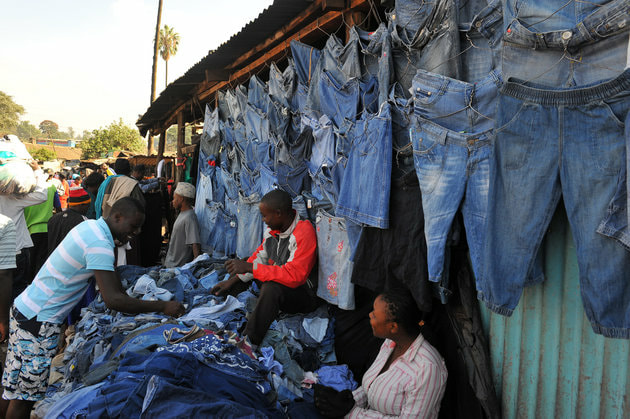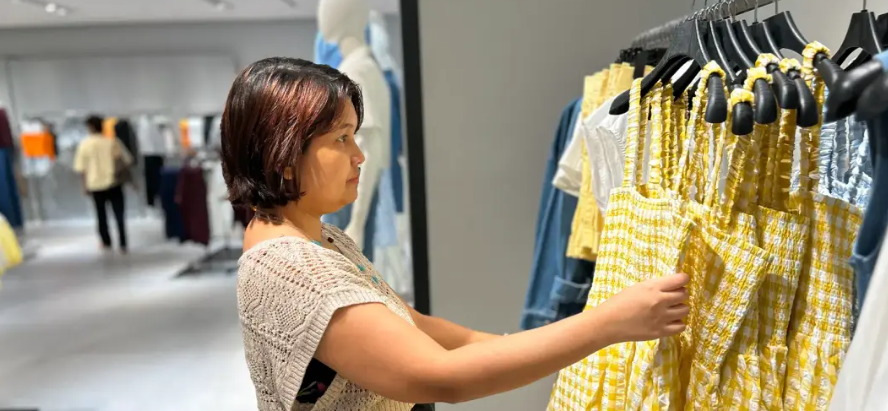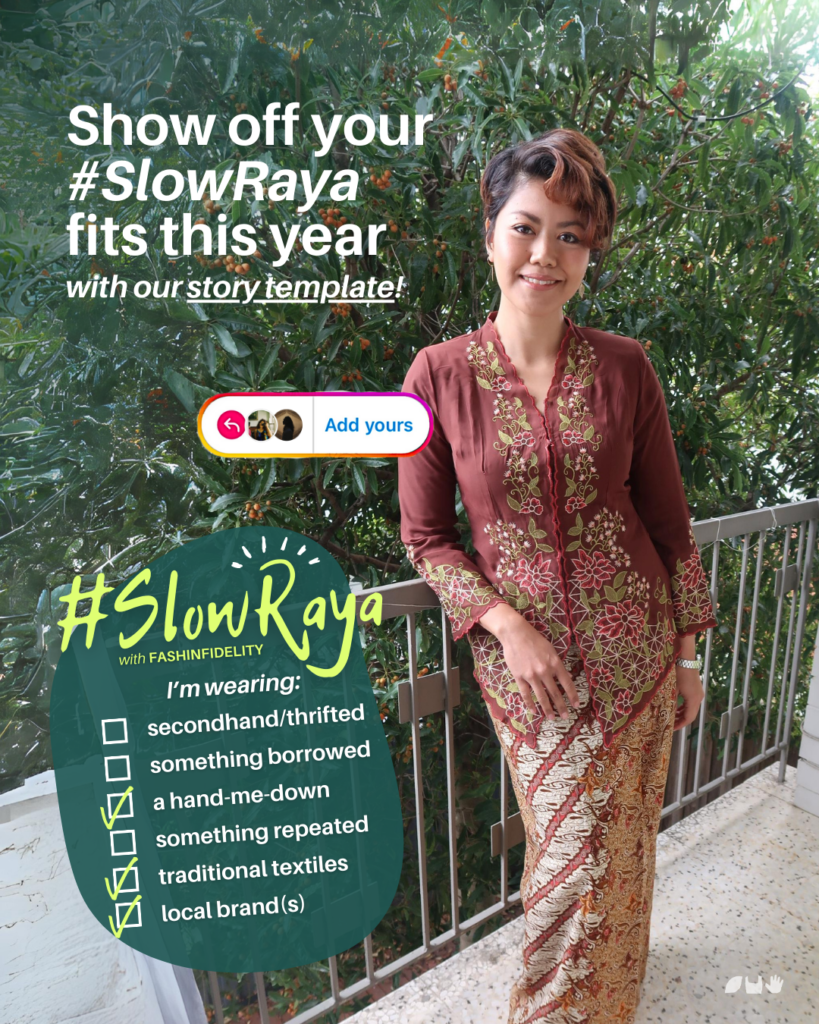1,354 words; 6 min read.
Hey guys, so it’s almost April, and I’m sorry I’ve been quiet. I’ve been a little busy with attending industry events and creating and curating my 2019 calendar, plus I’ve got some juicy video content that I’m working on that’s taken up a bit of my time.
Fashion Revolution Week is upon us too – April is an important month for #fashion!
So, to keep you up-to-date, here is some news that you need to know right now to keep you in good stead when you’re ‘working the room’ come April 22nd.
Above feature photo: A man samples secondhand clothes (locally known as mitumba) at the Gikomba open-air market on June 25, 2012, in Nairobi. (Photo: SIMON MAINA VIA GETTY IMAGES)
Best good news story, right from the hotdesk
The UN Alliance for Sustainable Fashion was launched on 15th March at the 4th UN Environment Assembly in Nairobi, Kenya. Its aim is to seek to halt the environmentally and socially destructive practices of fashion and instead harness the industry as a driver for improving the world’s ecosystems. The Alliance is improving collaboration among UN agencies by analysing their efforts in making fashion #sustainable, identifying solutions and gaps in their actions, and presenting these findings to governments to trigger policy. More on the story here. Why is this news important? Because Nairobi is home to the biggest secondhand clothing market in East Africa. Watch this very basic
investigative video on what happens to your old donated clothes and textile waste by Canadian Broadcasting Corporation
Sustainability movements across the world you might have missed
- Australia just hosted its inaugural industry-for-industry Australian Fashion Summit. Called LEGACY Responsible Fashion Summit, it took place in Sydney on 13th March for two days, with a soft launch at the Melbourne Fashion Festival in conjunction with International Womens Day on 8th March. Delivered by industry consultancy Ndless: The New Normal in partnership with The Australian Fashion Council and Fashion Revolution Australia, LEGACY Summit tackles some of the social and environmental challenges facing the fashion industry with practical initiatives, opportunities and solutions that brands and retailers can utilise for addressing them. Brands (Spell & The Gypsy Collective, Country Road Group and David Jones, Bianca Spender, Nudie Jeans), industry associations (Well Made Clothes, Ethical Trading Initiative), and experts (Clare Press) were present.
- The Australian Circular Fashion Conference (ACFC) grew bigger and stronger as it held its second event on 21st March at the St Kilda Town Hall in Melbourne (that yours truly attended), with an industry workshop event held the next day that focused on best practice & procurement, design & supply chain, suppliers & standards, CSR & marketing values, and stewardship. International (Mara Hoffman, Filippa.K, Eileen Fisher) and local (Australia Post, Cotton Australia, Salvos Stores) activists shared their stories and took on audience questions. Coverage by The Fashion Advocate on it here, and watch out for my take on it soon.
- Paris Aims to Be ‘Sustainable Capital of Fashion’ by 2024. “Paris Good Fashion,” an initiative supported by the office of Paris mayor Anne Hidalgo, made its debut at the Institut Français de la Mode on 28th January this year. Read all about it here.
- Indonesia Fashion Week 2019 is promoting eco-friendly fashion. The Association of Indonesian Fashion Designers and Entrepreneurs (APPMI), the organiser of the ongoing Indonesia Fashion Week (IFW) 2019, has announced its commitment to promoting #sustainability in the industry by supporting eco-friendly fashion at its launch on 27th March. Read about it here and here.

Celine DeCarlo, one of the industry experts who were present at the recent Australian Circular Fashion Conference, held on 21st March 2019.
Where fashion is at, right now
The Global Fashion Agenda and Boston Consulting Group, in its Pulse of the Fashion Industry Report, puts fashion, as an industry, responsible for the emission of 1,715 million tons of carbon dioxide equivalent (CO2-e) in 2015, about 5.4% of the 32.1 billion tons of global carbon emissions that year. The emission trail behind electricity and heat (24.9%), agriculture (13.8%), road transportation (10.5%), and oil and gas production (6.4%), and is equal to livestock (5.4%).
The Pulse of Fashion argues that the industry must do more to put fashion on a path to long-term prosperity — financially, socially, and environmentally — and measures its “Pulse” points (out of 100, based on metrics off the Sustainable Apparel Coalition’s Higg Index), to get there. Since 2017, their work has demonstrated that sustainability means good business. Their website states, “..new data and calculations show that investments in resource #efficiency, secure work environments and sustainable materials boost profitability by up to 1-2 percentage points in EBIT margin by 2030.” In the end though, they have summoned that it needs to be a joint effort by investors, regulators, NGOs, academia and consumers — to create an ecosystem that supports transformational innovation and disruptive business models. Check out an article about the Report here. As at May 2018, the industry’s Pulse sits at 32. The yearly Report’s release normally coincides with Copenhagen Fashion Summit, which brings us to…
Sustainability happenings that should be on your radar
- The Copenhagen Fashion Summit, the premier business event on sustainability in fashion is to be held on the 15-16th May, and has lined up highly esteemed names for the programme as speakers, in partnership with strategic partners like Kering, H&M, Target, Bestseller, Li & Fung and Sustainable Apparel Coalition. Global Fashion Agenda has been hosting the Summit since 2009. Buy tickets here and read more about it here. The Summit also plays host to 100 students from around the world who took part in a 2-year UN Global Compact challenge to thoroughly map Sustainable Development Goals 3 and 5 with regards to their visions and practicalities in fashion. The students will return in 2019 to present their case and demands for transforming the way fashion works in the future.
- To see a calendar of upcoming fashion weeks internationally, click here.
Some industry stats you should be aware of by now, really
- Fashion Revolution commissioned a survey of 5,000 people aged 16-75 in October 2018 in the five largest European markets, including Germany, United Kingdom, France, Italy and Spain, to find out how supply chain transparency and sustainability impacts consumers’ purchasing decisions when shopping for clothing, accessories and shoes. More of us in the region are concerned over the impact that mindlessly following trends and over-producing clothes are having. The Fashion Revolution Consumer Survey report’s key findings are that more people (39%) said that buying clothes made by workers paid a fair, living wage was important than any other topic surveyed, including: environmental protection (37%), safe working conditions (31%), animal welfare (30%), local production (10%) and use of recycled materials (6%).
- Young people in Asia do not have the same level of care, however, as Hong Kong based technology company Tofugear, in partnership with Rakuten Insight, has found. They have released a sweeping new report on the shopping behaviors of Asian consumers. The report, titled “The Digital Consumer in Asia 2018,” surveyed 6,000 consumers in 12 Asian countries in August 2018, and divided them into three generations – Gen Z, millennials and Gen X.
- The State of Fashion 2019 Report, the third of its kind and the most authoritative on the industry, written by McKinsey & Company in partnership with Business of Fashion (BoF) was released in November 2018. The Report forewarns a disruptive year ahead as sales growth is projected to slow slightly compared to 2018’s projections, across many value segments and regions, due to external shocks and economic uncertainty. The State of Fashion surveyed more than 275 global fashion executives (approximately 30 percent more than last year) and interviewed thought leaders and pioneers, and provides for insight into the Top Ten fashion trends of 2019. According to the Report, “regardless of size and segment, players now need to be nimble, think digital-first, and achieve ever-faster speed to market. They need to take an active stance on social issues, satisfy consumer demands for radical transparency and sustainability, and, most important, have the courage to “self-disrupt” their own identity and the sources of their old success to realise these changes and win new generations of customers.”
So there you have it – a healthy dose of fashion goodness enough to break your weekend reading list for now. I’ll be back with more!
Join us in our Slow Fashion movement with the hashtags #ConscientiousFashionista and #wardrobetruths on Instagram, and follow us at @fashinfidelity.
Tags: #ethicalfashion #sustainablefashion #ecofashion #greenfashion #responsiblefashion #circularfashion #circularity #conscientiousfashionista #fastfashion #slowfashion #sustainability #wardrobetruths #fashioneducation #fashionisnolongertrendy #fashion #saynotofastfashion #fashionnews #SDG #sustainabledevelopmentgoals #UNSDG #fashionrevolution #stateoffashion #bof #copenhagen #copenhagenfashionsummit #globalfashionagenda #gfa




